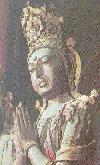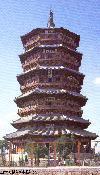|
Periods of Chinese History
|
 |

Pusa statue of Huayan Monastery 華嚴寺, Datong |

Timber pagoda of Fogong Monastery 佛宮寺, Yingxian |

Earthenware drinking vessel in the shape of a traditional leather canteen, Liao period |
Although the Liao empire imported Chinese handicraft articles and imitated Chinese art in all different kinds of art spheres, there are also many items and objects showing a genuine Khitan style, for example Buddhist architecture as seen in the main hall (Guanyinge 觀音閣 - the oldest preserved timber-made temple hall) of the Dule Monastery 獨樂寺 in Jixian 薊縣/Tianjin, the brick stupa of Tianning Monastery 天寧寺/Beijing, the pagoda in Ningcheng 寧城 (modern Chaoyang 朝陽/Liaoning), and the Timber Stupa of Fogong Monastery 佛宮寺 in Yingxian 應縣/Shanxi. All these stupas were octogonal and did not have a hollow interior like it was usage for the Tang 唐 and pre-Tang Buddhist architecture. This was a new architectural style that was typically for the Liao and Jin periods, while other Liao stupas like the white brick stupa of Linxi 林西 (near Chifeng 赤峰/Inner Mongolia) had a hollow interior until the top storey. In Huayan Monastery 華嚴寺 in Datong 大同/Shanxi some Buddhist clay statues of Bodhisattvas of the Liao period are preserved.
Porcelain and glazed earthenware was produced by the Khitan craftsmen, and their art did not only copy or imitate the Song porcelain style, but the shapes of drinking vessles imitate the shape of the old Khitan leather bags fixed to the horse saddles.
The Song period 宋 is known for the famous landscape paintings of Chinese artists. Khitan artists also engaged in painting and made painting presents to the Song emperors, like the hunting scenes painted by Emperor Liao Xingzong 遼興宗, or paintings by Yelü Bei 耶律倍. In the tombs of the Liao rulers (Liaomu 遼墓) in Kulun Banner 庫倫旗/Jilin we find mural paintings that show a clear influence of Tang mural painting .
2000 ff. © Ulrich Theobald · Mail
|
|
|